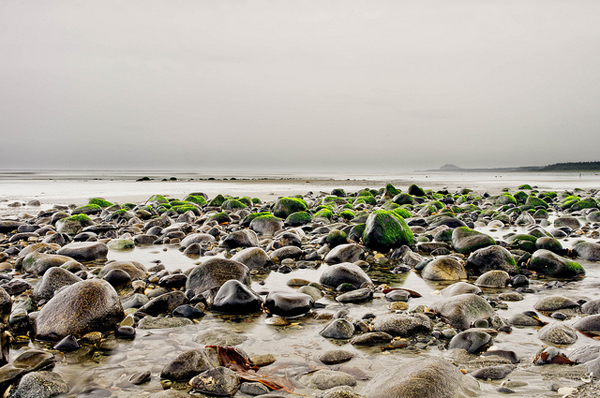After 11 years, millions of dollars, dozens of stakeholder meetings, and several unexpected bumps, a marine planning process that could impact the entire B.C. coast is nearing completion.
With an election ahead, environmental groups want to make sure the plan doesn't lose momentum. And a related poll by the David Suzuki Foundation found 95 per cent of British Columbians wanted more protection for their coastline.
"This is across partisan lines," Bill Wareham, marine conservation specialist with the David Suzuki Foundation told The Tyee earlier this week. "We want the governing party to continue to commit resources to it."
The rationale for better marine management was borne out of Canada's 1997 Oceans Act, a landmark piece of legislation passed by Jean Chretien's Liberals.
Both the act, and the subsequent Oceans Strategy, were designed to establish management and use plans for large marine areas around Canada's coast. They promoted an integrated management approach to ocean governance, dictating that these plans should be collaborative and coordinated in order to make sure that all marine uses -- industrial, agricultural or recreational -- happened within the ecological carrying capacity of a given area.
These pieces of legislation were the framework for the Pacific North Coast Integrated Management Area (PNCIMA, or pen-see-ma), a section of coastal and marine territory stretching from the north end of Vancouver Island to the Alaskan border.
Early planning stages began in 2002. Then, in Sept. 2011, the federal government withdrew from a funding agreement with other stakeholders. It did so under the auspices of streamlining, claiming that the previous plan was neither practical nor efficient enough to meet a Dec. 2012, deadline.
That funding agreement included $8.3 million from the California-based Gordon and Betty Moore Foundation, money administered by Tides Canada that had been part of a deal accepted by the federal government almost a year earlier. At the time, opposition MP Nathan Cullen charged that the move was politically motivated, accusing the Conservatives of undermining PNCIMA because it could have caused problems for the Enbridge Northern Gateway program.
Indeed, in March 2012, an investigation revealed that eight months prior to pulling support from PNCIMA, the federal government had been pressured by Enbridge, whose lobbyists argued that Tides Canada's involvement would hijack the process against the pipeline.
Strong support in BC for coastal protection: poll
In the meantime, the province and B.C. First Nations agreed to continue. Representatives from both governments put together a proposal and went back to the Gordon and Betty Moore Foundation, which agreed to fund a new process, without the federal government, now known as the Marine Planning Partnership, or MaPP.
Stakeholders from the province and First Nations are now engaged in meeting on the north coast, central coast, Haida Gwaii and North Vancouver Island. The work comes down to considering all the existing and potential uses for a given area, and determining what's appropriate, and what's not, given the ecosystem and local needs.
"They rekindled it," says Wareham. "It would be a shame to lose all that momentum... British Columbians really care about this."
In March, the David Suzuki Foundation commissioned a poll on the issue. It showed strong support for better coastal management; 65 per cent of the 807 adult British Columbians polled agreed MaPP was a good idea, and worthy of government resources, and 95 per cent said that more of Canada's coastline ought to be protected.
MaPP is designed to accommodate various uses while protecting important ecosystem values by, for example, re-allocating fishing activity, designating where tidal projects may occur, prohibiting recreation activities in certain areas or permitting it in others. It could severely limit activity in particularly sensitive ecosystems, like the glass sponge reefs of the Hecate Strait.
"It could definitely restrict where additional fish farms may or may not be located, and may recommend removing fish farms from some areas," says Wareham. "And as far as shipping goes, it could alter the routes that ships take through the region."
Although Wareham says "you never know" if a new NDP government would axe the process that started under Campbell's Liberals, it seems unlikely.
"You never know. We lived through the New Democratic Party government as well, when Glen Clark called us the enemies of B.C. It's strange politics in B.C."
In the 2011 leadership race, Adrian Dix released a seven-point environmental plan that included commitments to "expand B.C.'s marine protected areas and work with Ottawa and First Nations for a more comprehensive Pacific strategy for marine protected areas."
NDP environment critic Rob Fleming wouldn't say whether marine planning would be part of his party's platform this election ("I couldn't leak a detail like that," he said, chuckling), but did tell The Tyee that "our commitment to marine planning for the future has been strong."
Neither Liberal Environmental Minister Terry Lake nor Christy Clark's campaign coordinator returned The Tyee's calls by publication time.
Leveraging Ottawa
Perhaps the bigger question is how much the province can really do, given that much of the area covered by the marine planning partnership is under federal jurisdiction -- and, more importantly, how much the next provincial government will be willing to push the federal government on the plan's recommendations.
Although the province has jurisdiction between heads of land, in an inlet, for example, and authority over leases on the foreshore (anything activity that happens on land, but with a marine interface) most of the recommendations will fall on the federal government to enforce.
"It's tough because marine issues are the federal jurisdiction," says Christianne Wilhelmson, executive director of the Georgia Strait Alliance.
Although her organization is not directly involved in the process, it is part of Organizing for Change and have made sure that questions about marine planning are being asked. So far, says Wilhelmson, candidates have been silent on the issue.
"Generally find provincial candidates tend to shy away from marine issues until they're pressed on it," says Wilhelmson. "We believe it's important the province be there pressing the federal government for marine resources." ![]()
Read more: BC Politics, Environment, BC Election 2013
















Tyee Commenting Guidelines
Comments that violate guidelines risk being deleted, and violations may result in a temporary or permanent user ban. Maintain the spirit of good conversation to stay in the discussion.
*Please note The Tyee is not a forum for spreading misinformation about COVID-19, denying its existence or minimizing its risk to public health.
Do:
Do not: